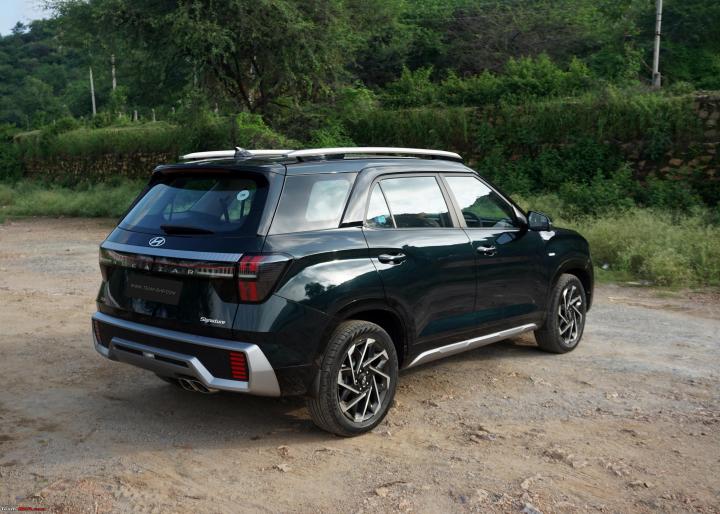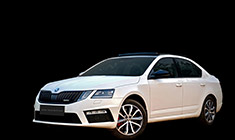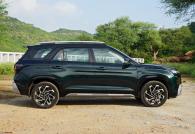News
2024 Hyundai Alcazar : Observations after a day of driving
Out on the highway, the Alcazar stays composed. Its road manners are neutral, just as you would expect from a 3-row family crossover. Straight line stability is good and you can cruise at highway speeds quite comfortably.
Driving the Hyundai Alcazar 1.5L Turbo-Petrol DCT Automatic

The 2024 Alcazar is powered by the same 1.5L turbo-petrol engine as the Hyundai Verna and Creta and the Kia Seltos and Carens. It produces an impressive 158 BHP (@ 5,500 rpm) and 253 Nm (@1,500-3,500 rpm). This 1.5L turbo-petrol engine is available with a 7-speed DCT automatic or a 6-speed MT. While the MT is available in the Executive, Prestige and Platinum variants, the DCT is available in the Platinum and Signature variants.
Fire up the engine, and it's refined at idle, silently purring away. Hyundai-Kia powertrains have always set NVH benchmarks, and this car is no different. Shift to D or R, and it moves off the line smoothly. Without any throttle input, the car crawls at 6 km/h. Crawling at city speeds isn’t very dramatic and the 1.5L is very well-behaved. With light to medium throttle inputs, you can go about your daily commute quite comfortably. The throttle response is smooth and power delivery is linear. The 7-speed dual-clutch transmission is also seamless moving through the gears. Start driving and you will appreciate the healthy low-end of this engine. Thanks to the turbocharger and direct injection, you’re never at a shortage of power. Just floor the accelerator if you want to close a gap in traffic or make that quick overtake and the engine and gearbox will do the rest.
Get on some open roads and you can let the Alcazar stretch its legs. Put your right foot down and before you know it, you’ll hit triple-digit speeds. Outright acceleration is good, but not as urgent as some other 1.5-litre turbo-petrols that we have driven. Hyundai claims a 0-100 km/h time of 9.5 seconds. The turbo delivers a strong mid-range punch that will take care of all the overtaking on the highway. You can cruise along the highway at 100 km/h while the engine spins at a relaxed ~1,850 rpm. Even at 120 km/h, the engine felt relaxed with the rev counter reading ~2,250 rpm. The Alcazar won't break a sweat cruising at these speeds all day long.
The dual-clutch transmission moves through the gears seamlessly. The kickdown response time is quick enough and the gearbox doesn’t hesitate to drop down the gears to get the engine into the powerband. When you are in the mood for some fun, switch to Sport mode and start flipping the paddle shifters for manual control. The ECU matches the revs which is always very satisfying. While the overall NVH package is good, the engine doesn't sound very sporty at high revs. Hyundai has restricted the maximum rpm to ~5,750, which is too low, and the engine sounds a bit strained at this rpm. The paddle shifters are responsive, and you can extract some performance from the engine using them for quick overtakes or keeping the engine in the powerband. You can engage the gearbox "S" mode by sliding the gear lever to the right (when in D) and this makes the gearbox hold on to the gears a bit longer. You can also take control of the gears using the paddle shifters and manually keep the engine in the power band.
The Alcazar gets 3 drive modes - Eco, Normal and Sport.
Eco Mode - Engage the Eco mode when you want to extract maximum fuel efficiency. The throttle response is dulled, but given the power on tap, the mode is quite comfortable to use in the city. In fact, we prefer driving in this mode in the city as the car becomes a lot smoother to drive. The Auto Start-Stop feature is activated automatically when you select the Eco mode. Also, while driving in the city in Eco mode, we noticed that the gearbox wasn't downshifting easily when the accelerator was pressed. It wanted to stay in the higher gears to extract more fuel efficiency.
Normal Mode - This is the default mode and just as the name suggests, it's normal to drive. There is a noticeable difference between Normal and Eco mode. This mode can be used for day-to-day driving which has a mix of city and open roads.
Sport Mode - Engage this mode when you want the car to be more responsive to your inputs. The throttle response is sharper, and the transmission also holds on to gears a bit longer in this mode. The steering is also noticeably heavier, although not as much as enthusiasts would like (more on this later). Sport mode isn't something you'd want to engage in the city as it can get a bit jerky to drive.
Noise, Vibration & Harshness (NVH)
The 1.5-litre unit is very refined overall. At city speeds as well as while cruising at 100 km/h, you can barely hear the engine in the cabin. Even the vibrations are well controlled and cruising with the family on the highway should be comfortable.
Tyre noise does creep into the cabin at highway speed and there is a hint of wind noise at speeds above 100 km/h.
Mileage & Fuel economy
The Alcazar comes equipped with an Auto Start-Stop feature that helps fuel efficiency in city driving conditions. The ARAI-certified fuel efficiency for the 1.5-litre turbo-petrol DCT is 18.0 km/l (17.5 km/l for the MT) which is substantially better than the 2.0-litre NA petrol of the old outgoing car (14.2 km/l). Of course, the real-world FE numbers will be much lower considering that turbo-petrol DCTs are very sensitive to the driving style. We’ll wait for some ownership reviews to get a better picture of real-world fuel efficiency. Fuel tank capacity remains the same at 50 litres and the refreshed Alcazar is E20 compatible.
Bonnet gets insulation underneath and helps keep the noise levels low:

Sufficient insulation on the firewall:

Healthy amount of underbody protection:

Suspension

Ride Comfort
The Alcazar rides on a McPherson strut suspension up front and a torsion beam setup at the rear. Start driving and you will immediately notice that the Alcazar rides in a comfortable manner. Low-speed ride quality is acceptably absorbent and even large potholes are handled well. IMHO, the suspension tune is perfect for a 6/7 seater like the Alcazar. It's neither too soft, nor too stiff.
The Alcazar rides on 215/55 section tyres on 18-inch wheels and has a recommended tyre pressure of 33 PSI (35 PSI - full load). The Executive and Prestige variants riding on 215/60 R17 tyres will offer a cushier ride.
Handling & Dynamics
Out on the highway, the Alcazar stays composed. Its road manners are neutral, just as you would expect from a 3-row family crossover. Straight line stability is good and you can cruise at highway speeds quite comfortably. However, it doesn't ride as flat as the Creta and high-speed undulations do make the car feel a bit wallowy.
Throw the Alcazar around a corner and it responds better than you'd expect from a 6/7 seater. Yes, there's body roll, but it's controlled. On curves, the car will hold its line pretty well. Good to know that all variants are equipped with ESP which can be a lifesaver in emergencies. The grip levels from the 215/55 R18 JK tyres are average. BHPians looking to extract some performance might want to upgrade to richer Michelin or Yokohama rubber.
Steering
The Alcazar gets a well-tuned EPS. It is one-finger light & smooth in the city. As the speedometer climbs, the EPS feels reasonably direct and fast too. The good all-round visibility, smooth gearboxes (automatics in particular) and light controls make this car easy to drive in urban conditions. On the highway, the steering feels stable and has no nervousness. However, we would have liked a bit more feedback from the steering.
Braking
Hyundai has made all-wheel disc brakes standard across all variants. Additionally, you also get brake assist and ABS. While braking at high speeds, the car stops in a straight line without any drama. No complaints in the braking area.
Niggles & Problems
The standard warranty of the Alcazar is 3 years/unlimited km which can be extended up to 7 years. You also get 3 years of roadside assistance. There are also 5 years of running repair and maintenance packages that you can opt for.
While most of the recent feedback about this 1.5-litre turbo-petrol has been positive, the turbo-petrol engine with the dual-clutch transmission is something you should be careful with. Our test car threw up a "Check Engine" light during the drive. We ran a check on the vehicle diagnostics and it told us to visit an authorised Hyundai dealer for inspection. This is the first time I have spotted a problem in a Hyundai test car.

It’s very much advisable to go for the maximum extended warranty. Don’t even think about it twice. It’s better to be safe than sorry.
Continue reading the discussion on the 2024 Hyundai Alcazar Facelift on our forum.




_2.jpg)













